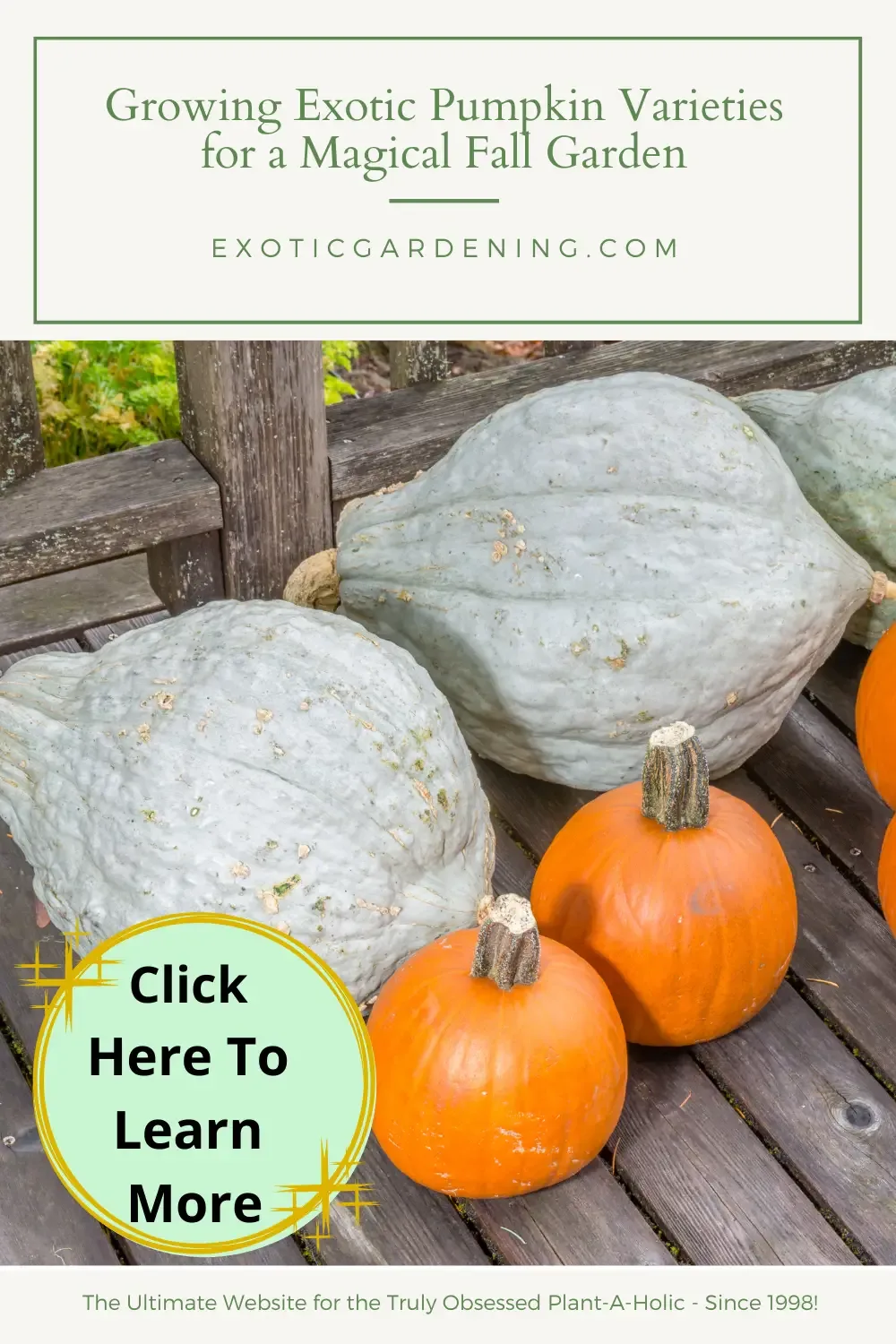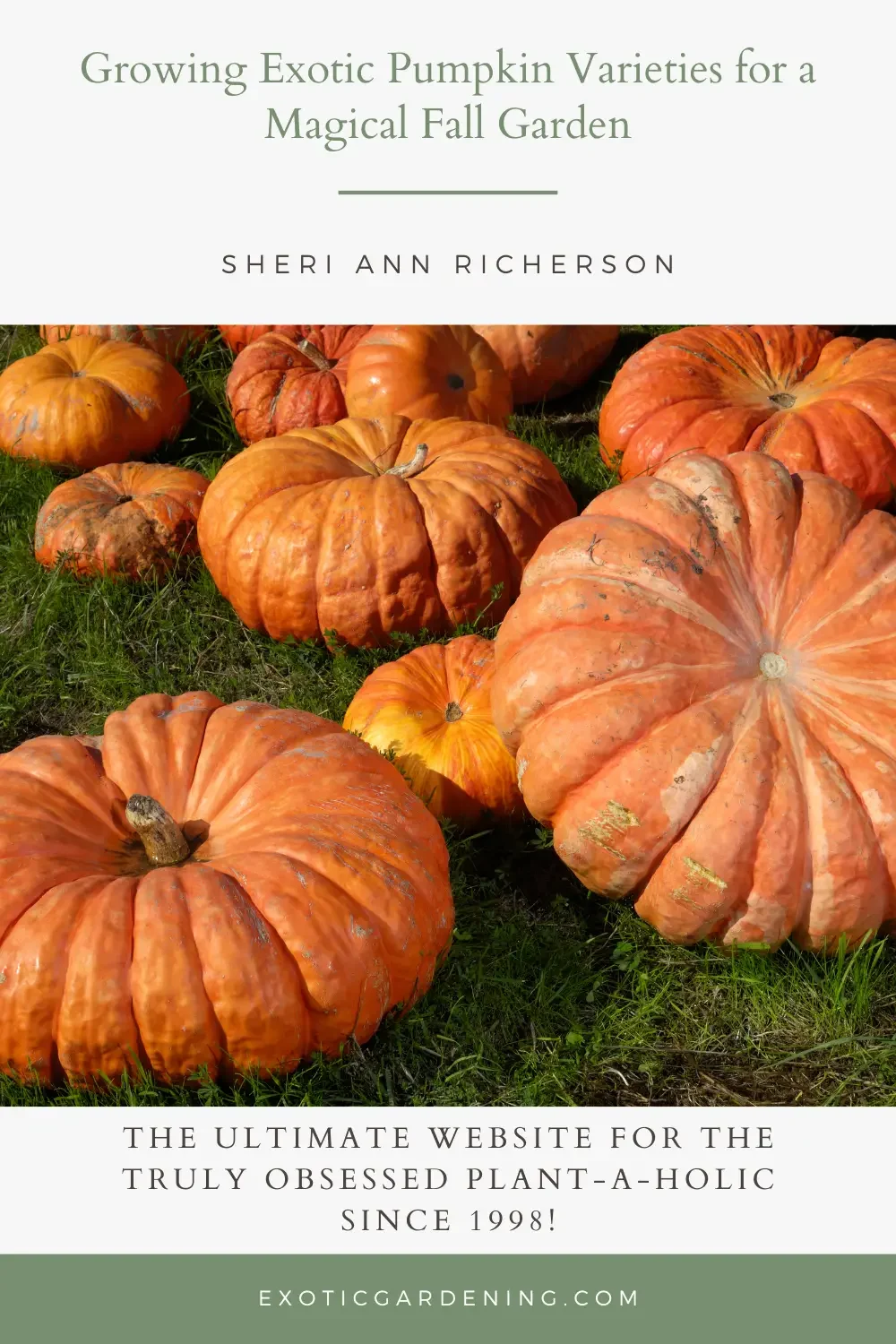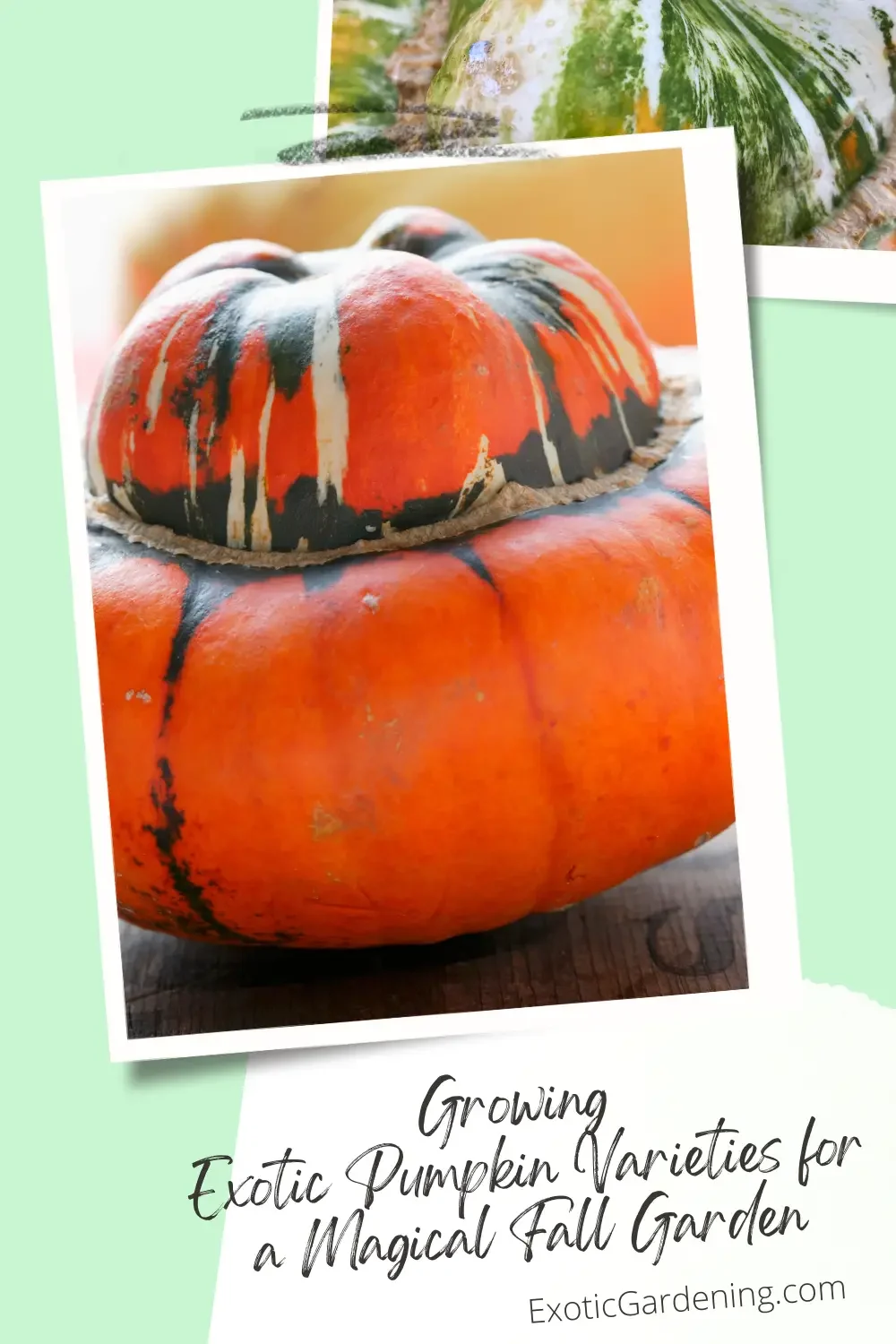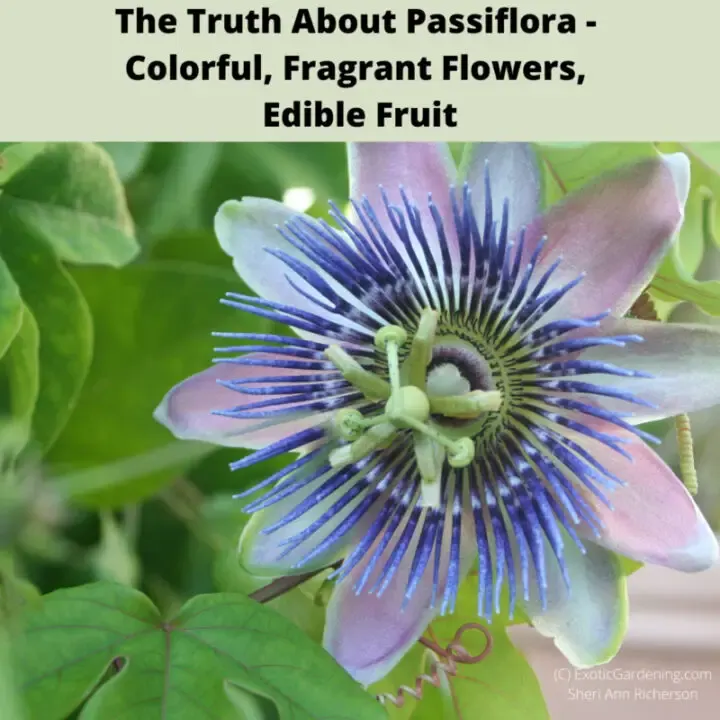As the air gets crisper and the leaves start to turn, it's impossible not to get caught up in the enchantment of fall.
And what better way to embrace the season than by adding some pumpkin spice right into your garden?
It's not just about pumpkins for pies and jack-o'-lanterns; there's a whole world of exotic pumpkin varieties waiting to grace your garden with their vibrant colors and unique flavors.
The Classic Pumpkin Spice
Before we jump into the exotic varieties, let's not forget the classic pumpkin spice player: the good ol' pumpkin.
Growing your own pumpkins for pies, lattes, and fall or Halloween decorations can be incredibly satisfying.
There's nothing quite like the earthy aroma of a freshly harvested pumpkin.
You can choose from various sizes, from the petite Sugar Pie pumpkins to the colossal Atlantic Giants.
Each has its charm and culinary uses, perfect for indulging in that classic pumpkin spice goodness.
Cinderella Pumpkins: A Fairytale Touch with a Parisian Twist
Have you ever heard of Cinderella pumpkins?
These magical, French heirloom varieties are sure to transport you to a fairytale world.
They're characterized by their squat, deeply ribbed shape, and they come in a stunning orange hue that screams autumn.
The best part?
They're not just for decoration.
Cinderella pumpkins have a deliciously sweet flesh that's perfect for pies and soups.
Imagine the aroma of a Cinderella pumpkin spice latte – pure fall bliss!
But wait, there's more to the pumpkin patch fantasy.
Let me introduce you to another enchanting character - the "Rouge Vif D'Etampes Pumpkin."
Rouge Vif D'Etampes Pumpkin: A Parisian Delight
Intriguingly, Rouge Vif D'Etampes was a beloved pumpkin in Parisian markets during the 1880s.
The name itself, translating to "Vivid Red from Etampes," pays homage to the medieval town just south of Paris where it was cultivated for market.
W. Atlee Burpee was the first to introduce Rouge Vif D'Etampes to U.S. gardeners in 1883.
These pumpkins are highly ornamental, with their stunning color and unique shape making them fit for a fairy tale.
They can easily steal the spotlight in your autumn displays.
But, here's the magical twist - Rouge Vif D'Etampes pumpkins are more than just a pretty face.
This variety is the standard for French soup stocks, thanks to its rich and flavorful flesh.
Each fruit can reach weights of up to 20 pounds, ensuring you have a hearty supply of this Parisian treasure all winter long.
So, in your fairytale pumpkin garden, they'll create a truly magical fall experience that's as delicious as it is enchanting.
Lumina Pumpkins: A Ghostly Glow with a Hint of Culinary Magic
If you're yearning to infuse your garden with an eerie yet elegant touch, Lumina pumpkins are the ethereal choice.
These unique white pumpkins resemble spectral apparitions nestled amidst their orange counterparts.
The mere glow from neighboring porch lights is enough to illuminate 'Lumina' with a ghostly radiance.
But there's a mesmerizing secret beneath their pale exterior.
Lumina transcends its role as a garden ghost; it's a versatile canvas for artistic carving and painting, courtesy of its remarkably smooth skin.
Picture a Lumina pumpkin adorned with a spice-scented candle, casting an enchanting glow under the night sky – it's a surefire way to infuse your garden with an otherworldly allure.
A Lustrous Ivory Pumpkin for the Creative Soul
Lumina, boasting its lustrous ivory skin, beckons to creative souls.
It's not just a pretty face; its flavor and texture are nothing short of exceptional.
These pumpkins typically measure 8"–10" in diameter and weigh in at a substantial 10–12 pounds each, making them a delightful addition to any garden.
Their growth is also a fun, engaging experience for kids.
What's even more captivating is Lumina's origin story.
It emerged as a serendipitous discovery in one of Hollar’s California pumpkin fields around two decades ago.
Since then, it has woven its unique appearance and versatility into the hearts of both young and old alike.
The Culinary Magic of Lumina
Lumina doesn't stop at aesthetics; it unveils its culinary prowess as well.
Its sweet, yellow flesh transforms cooking into a delightful adventure.
Whether you're inclined to whip up a creamy smoothie or a comforting pumpkin soup, Lumina's flesh is a culinary gem.
And here's the icing on the cake – Lumina stores exceptionally well if shielded from frost, ensuring that any artistry painted on its smooth surface remains vibrant for weeks, not mere days.
Under certain conditions, these enigmatic pumpkins may even develop intriguing blue patches, adding an extra layer of mystique to their ghostly allure.
Whether destined for your plate or intended as a canvas for artistic expression, Lumina is sure to shine in your garden, on your dining table, and in your creative endeavors.
It's the pumpkin that effortlessly bridges the gap between garden aesthetics and culinary delight.
Blue Hubbard Squash: Nature's Masterpiece of Flavor and History
Now, let's take a delightful detour from the ordinary and delve into the world of Blue Hubbard squash.
This exceptional variety, with its striking slate-blue skin, promises not only a feast for the senses but also a journey through history.
While it might not be a pumpkin by technical standards, its sweet and nutty flesh is a versatile ingredient that can effortlessly stand in for pumpkin in your cherished recipes.
Picture this: a roasted Blue Hubbard squash, adorned with just a delicate sprinkle of pumpkin spice.
It's an unexpected twist that will have your taste buds waltzing with delight.
A Storied Past and Unique Origin
The saga of Blue Hubbard squash unfolds in Marblehead, Massachusetts, in 1854 when it arrived in the holds of a ship from the West Indies.
The seeds of this colossal squash, originally hailing from South America, found their way into the hands of a local seedsman named J.H. Gregory.
Gregory, a shrewd breeder, saw something special in this squash and dedicated himself to refining its features.
He is credited with selecting for the distinctive blue color of the Hubbard's skin, making it the unique variety we cherish today.
The history of its name is equally intriguing.
Gregory attributed its discovery to a Miss Hubbard, who praised it as the best-tasting squash she had ever encountered.
According to her, the seeds were a gift from a ship's captain returning from the West Indies.
However, local lore presents a conflicting account, suggesting that Miss Hubbard may have actually cultivated the squash herself from seeds brought on the ship.
Regardless of its origins, the Blue Hubbard squash's thick skin made it an ideal choice for lengthy sea voyages, ensuring a long shelf life.
The Culinary Marvel of Blue Hubbard
In your kitchen, the Blue Hubbard squash is more than just a historical artifact; it's a culinary marvel.
With fruits that can range in weight from 15 to a remarkable 40 pounds each, it's a top choice for both restaurant chefs and family meals.
Its flesh boasts a silky texture and a flavor profile that harmonizes sweetness with nuttiness, making it a delectable addition to a variety of dishes.
Whether you decide to substitute it for pumpkin, butternut squash, or sweet potatoes in your recipes, the Blue Hubbard squash invites you to explore its rich history and savor its exquisite flavors.
It's a testament to nature's artistry and the legacy of culinary delight passed down through generations.
Prepare to embark on a flavorful journey that bridges the past and present with every delectable bite.
Red Kuri Squash: Nature's Rustic Gem
Let's dive into the captivating world of Red Kuri squash—an unsung hero that brings a rustic charm to both your garden and your table.
These little treasures don a striking red-orange coat and offer a flavor that's a delightful blend of sweetness and chestnut-like goodness.
While they may not wear the pumpkin badge, they're your ticket to a uniquely delicious pumpkin spice experience in your fall dishes.
A Taste of Japan's Culinary Heritage
Red Kuri squash, also known as Hokkaido pumpkin or onion squash, boasts a rich history in Japan.
These squash typically reach around 7 inches in diameter and weigh between 4 to 7 pounds.
They're cherished for their vibrant red-orange skin and golden-yellow flesh.
The name "kuri" pays homage to their sweet, nutty flavor, akin to chestnuts.
Culinary Adventures with Red Kuri Squash
Here's the fun part: Red Kuri squash is super versatile in the kitchen.
You can roast, bake, sauté, simmer, or even microwave them.
They work wonders in soups, sauces, jams, and dishes like casseroles, gratins, curries, and stews.
Storing Nature's Bounty
Storing Red Kuri squash is a breeze.
Keep them in a cool, dark spot at around 50°F, and they'll stay fresh for up to 9 months.
Once sliced, they'll last about a week in the fridge.
You can also freeze the flesh for up to six months.
So, as you welcome Red Kuri squash into your garden and celebrate their rustic charm in your cooking, remember you're not just adding flavor and color—you're honoring a rich culinary heritage.
Turban Squash: Nature's Exotic Headdress
Let's dive into the captivating world of Turban squash—a garden delight for the adventurous.
Picture a squash with a shape that's like a turban, available in vibrant colors, from orange to green.
These beauties aren't just for show; they offer a sweet, slightly nutty flavor, adding a unique twist to your pumpkin spice lineup.
Imagine the delight of your guests when you serve them a slice of Turban squash pie infused with all those classic spices.
Meet the Turban Squash
Turban squash is a medium-to-large winter squash, known for its irregular shape, hard, bumpy, multicolored skin, and sweet, nutty flavor.
It's a versatile ingredient for both sweet and savory dishes, including soups, stews, casseroles, and curries.
Unveiling Its Origin and Journey
Although Turban squash likely originated in the Caribbean, it took a culinary journey through France before becoming the American version we know today.
Early French cookbooks described it as watery and bland, but the American Turban squash emerged in the early 19th century as a hybrid of the French Turban squash and other squash varieties.
Due to its vibrant coloring, unique shape, and past reputation for mild flavor, Turban squash is often used for decoration rather than cooking.
Its shape is like a smaller squash bursting out of a larger one.
Cooking Up Turban Squash Magic
Preparing Turban squash can be a bit tricky due to its tough shell and irregular shape.
Some recipes involve separating the top part from the lower section to create a unique serving vessel.
However, the shell's thickness can make this a bit challenging.
But with patience and a sharp knife, it's doable.
Once the top is off, scoop out the pulp and seeds from both sections.
A quick steam makes it easier to extract the flesh.
Then, you can cook and puree the flesh, creating flavorful soups and serving them in the lower, hollowed-out section of the squash.
For a culinary adventure, stuff the lower portion, reattach the cap, and roast it to perfection.
A simpler approach is to halve the squash through the stem, scoop out the pulp and seeds, and roast it, cut-side down, in a 400°F oven until tender.
After roasting, simply scoop the flesh from the skin and savor it as is, mash it for a side dish, puree it for soup, or use it in various culinary creations.
Meet Marina di Chioggia
In the midst of this culinary adventure, let's introduce Marina di Chioggia pumpkin.
This heirloom sea pumpkin, hailing from the fishing village of Chioggia, is a true masterpiece.
With its large, turban-shaped fruit in deep blue-green, it stands as one of the most unique and beautiful squash varieties.
Each weighs around 10 pounds and boasts a rich, sweet, deep yellow-orange flesh.
Marina di Chioggia's story is a tale of cultural exchange.
While it likely had its roots in South America, it eventually found its way to Spain before capturing the hearts and kitchens of Italians.
The lagoons south of Venice have been a hub of cultivation for centuries, providing valuable vegetables, especially during the winter months.
Today, this remarkable squash still graces the canals of Venice, grilled with olive oil by bargemen, and served as a whole wedge—a delightful combination of sweet and savory.
As you explore Turban squash, from its striking appearance to its delightful flavors, and savor Marina di Chioggia's unique history and culinary versatility, you're not just enjoying a culinary journey; you're immersing yourself in a tapestry of flavors, traditions, and discoveries.
Tips for Growing Exotic Pumpkin Varieties
Before we wrap up our pumpkin spice garden adventure, let's chat about some essential tips for successfully growing these exotic pumpkin and squash varieties:
- Start Early: Pumpkin and squash varieties often have a longer growing season. Be sure to start your seeds indoors and transplant them when the danger of frost has passed.
- Rich Soil: These plants love well-drained, nutrient-rich soil. Compost and organic matter are your best friends when it comes to growing robust pumpkins and squash.
- Spacing: Give your pumpkin and squash plants plenty of room to spread out. They can be quite vigorous, so don't overcrowd them.
- Watering: Keep the soil consistently moist, especially during dry spells. These plants can be thirsty!
- Pest Control: Be on the lookout for common garden pests like aphids and squash bugs. Early detection and natural remedies like neem oil can help keep your plants healthy.
- Harvest at the Right Time: Harvest your pumpkins and squash when they have reached their full color and sound hollow when tapped. They'll be at their tastiest and spiciest!
Dealing with Blossom End Rot in Pumpkins
While we're celebrating the beauty of pumpkins, it's essential to address a common challenge many gardeners face: blossom end rot.
This condition can affect pumpkins and other fruiting vegetables, causing dark, sunken areas at the blossom end of the fruit.
Here's how to deal with it:
Understanding Blossom End Rot in Pumpkins
Blossom end rot is often caused by a calcium deficiency in the plant.
It can be a real frustration for gardeners, but there are ways to manage it.
Start by ensuring your soil has adequate calcium levels and consistent moisture.
Adding crushed eggshells to the soil can help provide a calcium boost naturally.
Preventing Blossom End Rot
Proper watering practices are crucial to prevent blossom end rot.
Keep the soil consistently moist, but avoid overwatering, as this can disrupt calcium uptake.
Mulching around your pumpkin plants can help regulate soil moisture and temperature.
Treating Affected Pumpkins
If you notice blossom end rot on your pumpkins, don't despair.
You can still salvage the unaffected portions of the fruit.
Simply cut away the affected area, and the rest of the pumpkin should be perfectly fine to use in your recipes.
This way, you can still enjoy your pumpkin spice treats without letting a little rot spoil the fun.
A Pumpkin Spice Garden Adventure
Incorporating exotic pumpkin and squash varieties into your garden is like bringing a touch of fall magic right to your doorstep.
Whether you choose the classic pumpkin or venture into the world of Cinderella pumpkins, Lumina pumpkins, or even Turban squash, you're in for a delightful journey of flavors and colors.
So, let's toast to the autumn season with a warm cup of homemade pumpkin spice latte, flavored with the fruits of your garden.
Share your experiences and favorite pumpkin spice recipes in the comments below.
I can't wait to hear about your garden adventures and the unique ways you're adding a dash of pumpkin spice to your gardening or homesteading life!
FAQ: Growing Exotic Pumpkin Varieties
Q: What are exotic pumpkin varieties?
A: Exotic pumpkin varieties are unique and uncommon types of pumpkins, often characterized by their distinctive shapes, colors, and flavors. They can add a touch of novelty to your garden and culinary creations.
Q: Are exotic pumpkins difficult to grow?
A: Exotic pumpkins are not necessarily harder to grow than traditional pumpkins. However, they may have specific requirements or growing conditions. Proper care, attention, and suitable soil can help ensure a successful harvest.
Q: Can I grow exotic pumpkins in colder climates?
A: Yes, you can! Some exotic pumpkin varieties, such as winter pumpkins, are well-suited for colder climates. They are bred to withstand chilly temperatures and can extend your pumpkin-growing season.
Q: What's the best way to use exotic pumpkins in recipes?
A: Exotic pumpkins can be used in various recipes, just like traditional pumpkins. You can make pies, soups, lattes, and more. Experiment with their unique flavors to create delightful dishes.
Q: How do I prevent blossom end rot in pumpkins?
A: To prevent blossom end rot, ensure your soil has adequate calcium levels and maintain consistent soil moisture. Proper watering practices and mulching can help regulate moisture and reduce the risk.
Q: Can I still use pumpkins with blossom end rot?
A: Yes, you can salvage unaffected portions of pumpkins with blossom end rot. Simply cut away the affected area, and the rest of the pumpkin is perfectly fine to use in recipes.
Q: Where can I find exotic pumpkin seeds?
A: You can find exotic pumpkin seeds at specialty seed suppliers, local nurseries, or even online. Look for heirloom or unique pumpkin varieties to start your garden adventure. My favorite place to find rare and exotic pumpkin seeds is Baker Creek Heirloom Seed Co.
Q: Are exotic pumpkins only for decoration?
A: Exotic pumpkins are not just for decoration; many of them have delicious, sweet flesh that's perfect for cooking. They can be both ornamental and culinary treasures in your garden.
Q: How do I store exotic pumpkins for the winter?
A: To store exotic pumpkins through the winter, keep them in a cool, dry place with good ventilation. They can last for several months if stored properly.
Q: What's the best way to enjoy pumpkin spice from my garden?
A: You can enjoy pumpkin spice from your garden by using your homegrown pumpkins or squash in recipes like pies, lattes, and soups. Savor the flavors of your garden in every bite and sip!
Fruits
How To Prepare Clay Soil For Blueberries
Learn how to prepare clay soil for blueberries with expert tips for optimal growth. Cultivate a thriving blueberry garden today!











